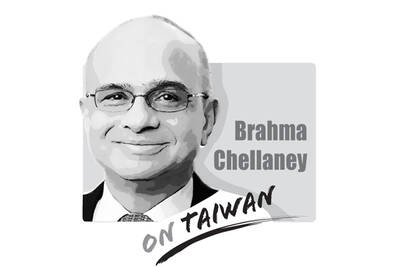Since US forces entered Baghdad and the regime of President Saddam Hussein collapsed, television channels have been showing images of Iraqi people welcoming the Americans and angrily trampling on Saddam's portraits and statues. Such images came as a big surprise to the academics and experts who had predicted a bloody battle on the streets of the Iraqi capital. They also astonished viewers around the world who were concerned about international affairs. Why was this?
Before Baghdad fell, Iraqi propaganda trumpeted the might of the country's army. So how could Saddam's troops so easily succumb? Television news channels showed Iraqi youths vowing to fight for Saddam against the US. So how come they seemed to be so quickly replaced by Iraqis welcoming Americans once Saddam's regime collapsed?
How could there be such a big difference between the Iraq of a few days ago and the one we see now? Which Iraq is the real one? Evidently the lies told by Saddam's regime over the past few decades were fragile. In a short three weeks, the US and British forces demolished the false impressions so sedulously built by Saddam's regime.
The astonishing images on television are reminiscent of the fall of the Berlin Wall and the Soviet Union. Before then, various US intelligence data had indicated that Soviet military power remained formidable and the Warsaw Pact still threatened NATO. The US and Western Europe had been living in the shadow of "red terror" since the end of World War II.
Remember Amerika, a TV miniseries produced in the US in the late 1980s which depicted the miserable lives of Americans after the US was invaded and occupied by the Soviet Union? Evidently some people were very pessimistic about US power.
Then suddenly the Berlin Wall came down and the East German regime collapsed and the two halves of Germany were unified. Then astonishing reports about the Soviet Union's collapse emerged. Many former members of the union declared independence. The "red terror" disappeared overnight. What was even more astonishing was the economic bankruptcy of the Soviet Union and Eastern European nations.
That chain of dramatic events came as a surprise to Western intelligence networks -- evidence that the ability of authoritarian regimes to create a facade of power far outweighed the ability of US intelligence agencies to detect the enemy's status.
Which brings us to the question of China. All the data we see about China at the moment paint a picture of a powerful, prosperous nation with high economic growth, where anti-West, anti-imperialist sentiments are on the rise and the determination to "retake" Taiwan remains strong. How true is this picture in a country where an authoritarian regime remains firmly in place and the people have no freedom of speech? Can we believe the images on television, the comments in newspapers or the figures provided by the authorities in Beijing?
Take the severe acute respiratory syndrome (SARS) outbreak for example. The spread of the disease can be very much attributed to the Chinese government's attempt to cover up the outbreak. For despots, truth is almost like poison. Which is why truth and despots never mix.
A democratic system can make a country's situation transparent. In a democratic country, voters will reject the government if it tells lies. This is why the people of Taiwan have been able to keep their heads up despite authoritarian China's oppression.
Now that US military action has exposed Saddam's lies, the people of Taiwan must ask, when will Beijing's lies be exposed? When will the people of Taiwan be free from "red terror"?

As strategic tensions escalate across the vast Indo-Pacific region, Taiwan has emerged as more than a potential flashpoint. It is the fulcrum upon which the credibility of the evolving American-led strategy of integrated deterrence now rests. How the US and regional powers like Japan respond to Taiwan’s defense, and how credible the deterrent against Chinese aggression proves to be, will profoundly shape the Indo-Pacific security architecture for years to come. A successful defense of Taiwan through strengthened deterrence in the Indo-Pacific would enhance the credibility of the US-led alliance system and underpin America’s global preeminence, while a failure of integrated deterrence would
The Executive Yuan recently revised a page of its Web site on ethnic groups in Taiwan, replacing the term “Han” (漢族) with “the rest of the population.” The page, which was updated on March 24, describes the composition of Taiwan’s registered households as indigenous (2.5 percent), foreign origin (1.2 percent) and the rest of the population (96.2 percent). The change was picked up by a social media user and amplified by local media, sparking heated discussion over the weekend. The pan-blue and pro-China camp called it a politically motivated desinicization attempt to obscure the Han Chinese ethnicity of most Taiwanese.
On Wednesday last week, the Rossiyskaya Gazeta published an article by Chinese President Xi Jinping (習近平) asserting the People’s Republic of China’s (PRC) territorial claim over Taiwan effective 1945, predicated upon instruments such as the 1943 Cairo Declaration and the 1945 Potsdam Proclamation. The article further contended that this de jure and de facto status was subsequently reaffirmed by UN General Assembly Resolution 2758 of 1971. The Ministry of Foreign Affairs promptly issued a statement categorically repudiating these assertions. In addition to the reasons put forward by the ministry, I believe that China’s assertions are open to questions in international
The Legislative Yuan passed an amendment on Friday last week to add four national holidays and make Workers’ Day a national holiday for all sectors — a move referred to as “four plus one.” The Chinese Nationalist Party (KMT) and the Taiwan People’s Party (TPP), who used their combined legislative majority to push the bill through its third reading, claim the holidays were chosen based on their inherent significance and social relevance. However, in passing the amendment, they have stuck to the traditional mindset of taking a holiday just for the sake of it, failing to make good use of